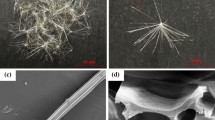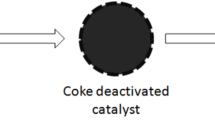Abstract
The use of cork granules for cleaning up crude oil or oil derivative spills and further oil recovery appears as a promising option due to their unique properties, which allow a high oil sorption capacity, low water pickup and excellent reuse. The present work reports the effect of oil viscosity on cork sorption capacity by using five types of oils (lubricating oil, 5.7 goil gcork−1; heavy oil, 4.2 goil gcork−1; light oil, 3.0 goil gcork−1; biodiesel, 2.6 goil gcork−1; and diesel, 2.0 goil gcork−1). The cork sorption capacity for light petroleum was also evaluated as a function of temperature and sorbent particle size. Additionally, improvements on oil recovery from cork sorbents by a mechanical compression process have been achieved as a result of a design of experiments (DOE) using the response surface methodology. Such statistical technique provided remarkable results in terms of cork sorbent reusability, as the oil sorption capacity was preserved after 30 cycles of sorption-squeezing steps. The sorbed oils could be removed from the sorbent surface, collected simply by squeezing the cork granules and further reused. The best operational region yielded near 80% oil recovery, using a cork mass of 8.85 g (particle size of 2.0–4.0 mm) loaded with 43.5 mL of lubricating oil, at 5.4 bar, utilising two compressions with a duration of 2 min each.

Graphical abstract










Similar content being viewed by others
Change history
19 December 2019
The original publication of this paper contains a mistake.
Abbreviations
- ANOVA:
-
Analysis of variance
- F calc :
-
F value calculated
- F tab :
-
F value tabulated
- R 2 :
-
Coefficient of determination
- RGC:
-
Regranulated cork
- CCD:
-
Central composite design
- DOE:
-
Design of experiments
- SEM:
-
Scanning electron microscopy
- TGA:
-
Thermogravimetric analysis
- DrTGA:
-
Differential thermal analysis
- RSM:
-
Response surface methodology
- FTIR:
-
Fourier transform infrared
- α :
-
Significance level
- n :
-
Number of experiments
- k :
-
Factors
- m c :
-
Mass of cork (g)
- m oc :
-
Mass of cork impregnated with oil (g)
- m ocd :
-
Mass of cork impregnated with oil after compression (g)
- m o :
-
Mass of oil (g)
- N c :
-
Number of compressions
- q Sat :
-
Amount of sorbed oil per mass of cork particles during the saturations step (goil gparticles−1)
- q comp :
-
Amount of desorbed oil per mass of cork particles for each compression cycles (goil gparticles−1)
- R (%):
-
Oil recovery percentage
- t c :
-
Compression time (min)
- t w :
-
Waiting time (min)
- P :
-
Pressure (bar)
- A, B, C, D :
-
Independent variables or factors (coded as pressure, cork mass, number of compressions and compressing time, respectively).
References
Abdullah MA, Rahmah AU, Man Z (2010) Physicochemical and sorption characteristics of Malaysian Ceiba pentandra (L.) Gaertn. as a natural oil sorbent. J Hazard Mater 177:683–691
Adebajo MO, Frost RL, Kloprogge JT, Carmody O, Kokot S (2003) Porous materials for oil spill vleanup: a teview of synthesis and absorbing properties. J Porous Mater 10:159–170
Alaa El-Din G, Amer AA, Malsh G, Hussein M (2017): Study on the use of banana peels for oil spill removal. Alexandria Engineering Journal
Amorim Isolamentos SA (2005) CORKSORB: sustainable absorbents 100% natural. In: Amorim Isolamentos SA (Hrsg.), Mozelos, Portugal
Bandura L, Franus M, Józefaciuk G, Franus W (2015) Synthetic zeolites from fly ash as effective mineral sorbents for land-based petroleum spills cleanup. Fuel 147:100–107
Bandura L, Woszuk A, Kołodyńska D, Franus W (2017) Application of mineral sorbents for removal of Petroleum substances: a review. Minerals 7:37
Behnood R, Anvaripour B, Jaafarzade Haghighi Fard N, Farasati M (2013) Petroleum hydrocarbons adsorption from aqueous solution by raw sugarcane bagasse. Int J Emerg Sci Eng 1:96–99
Bento MF, Pereira H, Cunha MÁ, Moutinho AMC, Berg KJvd, Boon JJ, Brink Ovd, Heeren RMA (2001) fragmentation of suberin and composition of aliphatic monomers released by methanolysis of cork from Quercus suber L., Analysed by GC-MS, SEC and MALDI-MS, Holzforschung, pp 487
Broje V, Keller A (2006) Improved recovery of oil spills from water surfaces using tailored surfaces in oleophilic skimmers. United States Environmental Protection Agency (EPA), pp 1–14
Do TTT, Dao UPN, Bui HT, Nguyen TT (2017): Effect of electrostatic interaction between fluoxetine and lipid membranes on the partitioning of fluoxetine investigated using second derivative spectrophotometry and FTIR. Chemistry and Physics of Lipids 207, Part A, 10-23
Duarte AP, Bordado JC (2015) Cork—a renewable raw material: forecast of industrial potential and development priorities. Front Mater 2
Fingas M (2013) The basics of oil spill cleanup. CRC Press, New York
Galblaub OA, Shaykhiev IG, Stepanova SV, Timirbaeva GR (2016) Oil spill cleanup of water surface by plant-based sorbents: Russian practices. Process Saf Environ Prot 101:88–92
Ge J, Zhao HY, Zhu HW, Huang J, Shi LA, Yu SH (2016) Advanced sorbents for oil-spill cleanup: recent advances and huture perspectives. Adv Mater 28:10459–10490
Geacai S, Iulian O, Nita I (2015) Measurement, correlation and prediction of biodiesel blends viscosity. Fuel 143:268–274
Gu J, Jiang W, Wang F, Chen M, Mao J, Xie T (2014) Facile removal of oils from water surfaces through highly hydrophobic and magnetic polymer nanocomposites. Appl Surf Sci 301:492–499
Lazić ŽR (2004) Design of experiments in chemical engineering. WILEY-VCH Verlag GmbH & Co, Weinheim
Lequin S, Chassagne D, Karbowiak T, Gougeon R, Brachais L, Bellat J-P (2010) Adsorption equilibria of water vapor on cork. J Agric Food Chem 58:3438–3445
Lin C, Huang C-L, Shern C-C (2008) Recycling waste tire powder for the recovery of oil spills. Resour Conserv Recycl 52:1162–1166
Manohar N, Jayaramudu J, Suchismita S, Rajkumar K, Babul Reddy A, Sadiku ER, Priti R, Maurya DJ (2017) A unique application of the second order derivative of FTIR–ATR spectra for compositional analyses of natural rubber and polychloroprene rubber and their blends. Polym Test 62:447–453
Montgomery DC (2017) Design and analysis of experiments. John Wiley & Sons
Moon C, Sung Y, Ahn S, Kim T, Choi G, Kim D (2013) Thermochemical and combustion behaviors of coals of different ranks and their blends for pulverized-coal combustion. Appl Therm Eng 54:111–119
Neto CP, Rocha J, Gil A, Cordeiro N, Esculcas AP, Rocha S, Delgadillo I, De Jesus JDP, Correia AJF (1995) 13C solid-state nuclear magnetic resonance and Fourier transform infrared studies of the thermal decomposition of cork. Solid State Nucl Magn Reson 4:143–151
Olga VR, Darina VI, Alexandr AI, Alexandra АO (2014) Cleanup of water surface from oil spills using natural sorbent materials. Procedia Chem 10:145–150
Oliveira FR, Silva EAA, do Carmo SN, Steffens F, Souto A, Valadares NPG (2014) Functionalization of natural cork composite with microcapsules after plasma treatment. Adv Mater Sci Eng 2014:8
Olivella MA, Jové P, Sen A, Pereira H, Villaescusa I, Fiol N (2011) Sorption performance of quercus cerris cork with polycyclic aromatic hydrocarbons and toxicity testing. BioResources 6:3363–3375
Oribayo O, Feng X, Rempel GL, Pan Q (2017) Modification of formaldehyde-melamine-sodium bisulfite copolymer foam and its application as effective sorbents for clean up of oil spills. Chem Eng Sci 160:384–395
Ozan Aydin G, Bulbul Sonmez H (2015) Hydrophobic poly(alkoxysilane) organogels as sorbent material for oil spill cleanup. Mar Pollut Bull 96:155–164
Pereira H (1988) Chemical composition and variability of cork from Quercus suber L. Wood Sci Technol 22:211–218
Pintor AMA, Ferreira CIA, Pereira JC, Correia P, Silva SP, Vilar VJP, Botelho CMS, Boaventura RAR (2012) Use of cork powder and granules for the adsorption of pollutants: a review. Water Res 46:3152–3166
Pintor AMA, Ferreira CIA, Pereira JPC, Souza RS, Silva SP, Vilar VJP, Botelho CMS, Boaventura RAR (2015) Oil desorption and recovery from cork sorbents. J Environ Chem Eng 3:2917–2923
Pintor AMA, Vilar VJP, Botelho CMS, Boaventura RAR (2016) Oil and grease removal from wastewaters: sorption treatment as an alternative to state-of-the-art technologies. A critical review. Chem Eng J 297:229–255
Porto PSS, Souza RS, Pesqueira JFJR, Boaventura RAR, Vilar VJP (2017) Mineral oil recovery from cork granules by a mechanical compression method: compression cycles analysis. J Clean Prod 147:442–450
Radetic MM, Jocic DM, Jovancic PM, Petrovic ZL, Thomas HF (2003) Recycled wool-based nonwoven material as an oil sorbent. Environ Sci Technol 37:1008–1012
Ragle LE, Palanisamy DJ, Joe MJ, Stein RS, Norman DD, Tigyi G, Baker DL, Parrill AL (2016) Discovery and synthetic optimization of a novel scaffold for hydrophobic tunnel-targeted autotaxin inhibition. Bioorg Med Chem 24:4660–4674
Rosa ME, Fortes MA (1988) Temperature-induced alterations of the structure and mechanical properties of cork. Mater Sci Eng 100:69–78
Saito M, Ishii N, Ogura S, Maemura S, Suzuki H (2003) Development and Water Tank Tests of Sugi Bark Sorbent (SBS). Spill Sci Technol Bull 8:475–482
Santoso H, Iryanto, Inggrid M (2014) Effects of temperature, pressure, preheating time and pressing time on rubber seed oil extraction using hydraulic press. Procedia Chem 9:248–256
Segovia JJ, Fandiño O, López ER, Lugo L, Carmen Martín M, Fernández J (2009) Automated densimetric system: measurements and uncertainties for compressed fluids. J Chem Thermodyn 41:632–638
Şen A, Marques AV, Gominho J, Pereira H (2012) Study of thermochemical treatments of cork in the 150–400 °C range using colour analysis and FTIR spectroscopy. Ind Crop Prod 38:132–138
Silva S, Sabino M, Fernandes E, Correlo V, Boesel L, Reis R (2005) Cork: properties, capabilities and applications. Int Mater Rev 50:345–365
Sinha LK, Haldar S, Majumdar GC (2015) Effect of operating parameters on mechanical expression of solvent-soaked soybean-grits. J Food Sci Technol 52:2942–2949
Valix M, Katyal S, Cheung WH (2017) Combustion of thermochemically torrefied sugar cane bagasse. Bioresour Technol 223:202–209
Wang J, Geng G (2015) Highly recyclable superhydrophobic sponge suitable for the selective sorption of high viscosity oil from water. Mar Pollut Bull 97:118–124
Wang D, McLaughlin E, Pfeffer R, Lin YS (2012) Adsorption of oils from pure liquid and oil–water emulsion on hydrophobic silica aerogels. Sep Purif Technol 99:28–35
Wang Y, Zhu L, Zhu F, You L, Shen X, Li S (2017) Removal of organic solvents/oils using carbon aerogels derived from waste durian shell. J Taiwan Inst Chem Eng 78:351–358
Wu D, Fang L, Qin Y, Wu W, Mao C, Zhu H (2014) Oil sorbents with high sorption capacity, oil/water selectivity and reusability for oil spill cleanup. Mar Pollut Bull 84:263–267
Funding
This work was financially supported by Associate Laboratory LSRE-LCM-UID/EQU/50020/2019-funded by national funds through FCT/MCTES (PIDDAC). Vítor J.P. Vilar acknowledges the FCT Individual Call to Scientific Employment Stimulus 2017 (CEECIND/01317/2017) and the Special Visiting Researcher Program PVE (CAPES Project No. A069/2013). F.V Hackbarth acknowledges her postdoctoral fellowship provided by CAPES PNPD, and the postgraduate programme in chemical engineering of the Federal University of Santa Catarina. D. Todescato acknowledges his Doctoral fellowship provided by CNPq, CAPES (BEX 99999.007222/2015-07) and ANP-PRH09. This work was developed in the scope of the project CICECO-Aveiro Institute of Materials, POCI-01-0145-FEDER-007679 (ref. FCT UID/CTM/50011/2013), funded by FEDER through COMPETE2020-Programa Operacional Competitividade e Internacionalização (POCI) and by national funds through FCT-Fundação para a Ciência e a Tecnologia. P. J. Carvalho acknowledges FCT for a contract under the Investigador FCT 2015, Contract IF/00758/2015.
Author information
Authors and Affiliations
Corresponding author
Additional information
Responsible editor: Philippe Garrigues
Publisher’s note
Springer Nature remains neutral with regard to jurisdictional claims in published maps and institutional affiliations.
The original article was revised: The original publication of this paper contains a mistake.
The correct title is shown in this paper.
Electronic supplementary material
ESM 1
(DOCX 33 kb)
Rights and permissions
About this article
Cite this article
Todescato, D., Hackbarth, F.V., Carvalho, P.J. et al. Use of cork granules as an effective sustainable material to clean-up spills of crude oil and derivatives. Environ Sci Pollut Res 27, 366–378 (2020). https://doi.org/10.1007/s11356-019-06743-1
Received:
Accepted:
Published:
Issue Date:
DOI: https://doi.org/10.1007/s11356-019-06743-1




